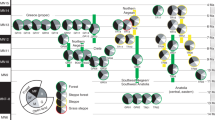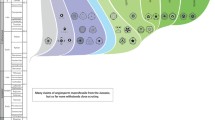Abstract
One of the grand objectives in the integration of fossils and phylogenetics is to obtain support for macroecological and macroevolutionary hypotheses. Here, we provide new evidence from Dominican amber fossils, which supports a likely stasis in the generic composition of epiphytic plant communities in the West Indies for at least 16 million years. The proposed hypothesis is based on the discovery of the first fossil of the Neotropical fern genus Pleopeltis. The relationships of this specimen to extant genera are studied using a dated phylogenetic framework to reconstruct the evolution of the characters preserved in the fossil, as well as by exploring the phylomorphospace of Pleopeltis. The fossil corroborates divergence time estimates obtained independently and also suggests the conservation of the generic composition of epiphytic communities. We discovered evidence for conserved morphotypes in the genus Pleopeltis occurring from the mid-Miocene to the present. The innovative use of phylomorphospace reconstruction provided crucial information about the affinities of the fossil. Rather than relying on reconstructing the evolution of single characters, this analysis integrates the evolution of all informative characters observed to evaluate relationships of the fossilized morphotype to extant morphotypes.



Similar content being viewed by others
References
Collinson, M. E. (2001). Cainozoic ferns and their distribution. Brittonia, 53, 173–235.
Drummond, A. J., & Suchard, M. A. (2010). Bayesian random local clocks, or one rate to rule them all. BMC Biology, 8, 114. doi:10.1186/1741-700708-114.
Drummond, A. J., Suchard, M. A., Xie, D., & Rambaut, A. (2012). Bayesian phylogenetics with BEAUTi and the BEAST 1.7. Molecular Biology Evolution, 29, 1969–1973.
Frahm, J. P., & Newton, A. E. (2005). A new contribution to the moss flora of Dominican amber. The Bryologist, 108, 526–536.
Gomez, L. D. (1982). Grammitis succinea, the first new world fern found in amber. American Fern Journal, 72, 49–52.
Gradstein, S. R. (1993). New fossil Hepaticae preserved in amber of the Dominican Republic. Nova Hedwigia, 57, 353–374.
Gradstein, F. M., Ogg, J., & Smith, A. (2004). A geological time scale. Cambridge: Cambridge University Press.
Grolle, R. (1984). Bryopteris and Cyclolejeunea fossil in dominikanischem Bernstein. Journal of the Hattori Botanical Laboratory, 56, 271–280.
Hammer, O., Harper, D.A.T., & Ryan, P.D. (2001). PAST: paleontological statistics software package for education and data analyses. Palaeontologica. Electronica 4, 9. http://palaeo-electronica.org/2001_1/past/issue1_01.htm.
Heinrichs, J., Vitt, D. H., Schäfer-Verwimp, A., Ragazzi, E., Marzaro, G., Grimaldi, D. A., Nascimbene, P. C., Feldberg, K., & Schmidt, A. R. (2013). The moss Macromitrium richardii (Orthotrichaceae) with sporophyte and calyptra enclosed in Hymenaea resin from the Dominican Republic. Polish Botanical Journal, 58, 221–230.
Hirai, R. Y., Rouhan, G., Labiak, P. H., Ranker, T. A., & Prado, J. (2011). Moranopteris: a new neotropical genus of grammitid ferns (Polypodiaceae) segregated from Asian Micropolypodium. Taxon, 60, 1123–1137.
Iturralde-Vinent, M. A. (2001). Geology of the amber-bearing deposits of the Greater Antilles. Caribbean Journal Earth Sciences, 37, 141–167.
Jacques, F. M. B., Su, T., & Zhou, Z. K. (2013). The first fossil microsoroid fern (Palaeosorum ellipticum gen. et sp. nov.) from the middle Miocene of Yunnan, SE China. Journal of Systematics and Evolution, 51, 758–764.
Janssen, T., Kreier, H. P., & Schneider, H. (2007). Origin and diversification of African ferns with special emphasis on Polypodiaceae. Brittonia, 59, 159–181.
Kessler, M., Velazquez, A. L. M., Sundue, M., & Labiak, P. H. (2011). Alansmia, a new genus of grammitid ferns (Polypodiaceae) segregated from Terpsichore. Brittonia, 63, 233–244.
Kreier, H. P., & Schneider, H. (2006). Phylogeny and biogeography of the staghorn fern genus Platycerium (Polypodiacae, Polypodiidae). American Journal of Botany, 93, 217–225.
Kreier, H. P., Rex, M., Weising, K., Kessler, M., Smith, A. R., & Schneider, H. (2008). Inferring the diversification of the epiphytic fern genus Serpocaulon (Polypodiaceae) in South America using chloroplast sequences and amplified fragment length polymorphisms. Plant Systematics and Evolution, 274, 1–16.
Kvacek, Z. (2001). A new fossil species of Polypodium (Polypodiaceae) from the Oligocene of northern Bohemia (Czech Republic). Feddes Repertorium, 122, 159–177.
Kvacek, Z., Daskova, J., & Zetter, R. (2004). A re-examination of Cenozoic Polypodium in North America. Review of Palaeobotany and Palynology, 128, 219–227.
Labiak, P. H. (2011). Stegnogrammitis, a new genus of grammitid ferns segregated from Lellingeria (Polypodiaceae). Brittonia, 63, 139–149.
Labiak, P. H., Sundue, M., & Rouhan, G. (2010). Molecular phylogeny, character evolution, and biogeography of the grammitid fern genus Lellingeria (Polypodiaceae). American Journal of Botany, 97, 1354–1364.
Lóriga, J., Schmidt, A. R., Moran, R. C., Feldberg, K., Schneider, H., & Heinrichs, J. (2014). The first fossil of a bolbitidoid fern belong to the early-divergent lineages of Elaphoglossum (Dryopteriaceae). American Journal of Botany, 101, 1466–1475.
Maddison, W.P., & Maddison, D.R. (2012). Mesquite: a modular system for evolutionary analysis. http://mesquiteproject.org.
Midford, P.E., Garland, Jr. T., & Maddison, W.P. (2011). PDAP Package of Mesquite v. 1.1.6. http://mesquiteproject.org/pdap_mesquite/index.html.
Otto, E. M., Janssen, T., Kreier, H. P., & Schneider, H. (2009). New insights into the phylogeny of Pleopeltis and related Neotropical genera (Polypodiaceae, Polypodiopsida). Molecular Phylogenetics and Evolution, 53, 190–201.
Ranker, T. A., Smith, A. R., Parris, B. S., Geiger, J. M. O., Haufler, C. H., Straub, S. C. K., & Schneider, H. (2004). Phylogeny and evolution of grammitid ferns (Grammitidaceae): a case of rampant morphological homoplasy. Taxon, 53, 415–428.
Reiner-Drehwald, M. E., Schmidt, A. R., & Heinrichs, J. (2012). The genus Lejeunea in Miocene amber from the Dominican Republic. Cryptogamie Bryologie, 33, 33–38.
Rouhan, G., Labiak, P. H., Randrianjohany, E., & Rakotondrainibe, F. M. (2012). Not so Neotropical after all: the grammitid fern genus Leucotrichum (Polypodiaceae) is also paleotropical, as revealed by a new species from Madagascar. Systematic Botany, 37, 331–338.
Schneider, H., Smith, A. R., Cranfill, R., Hildebrand, T. J., Haufler, C. H., & Ranker, T. A. (2004). Unravelling the phylogeny of polygrammoid ferns (Polypodiaceae and Grammitidaceae); exploring aspects of the diversification of epiphytic plants. Molecular Phylogenetics and Evolution, 31, 1041–1063.
Schneider, H., Kreier, H. P., Wilson, R., & Smith, A. R. (2006). The Synammia enigma: evidence for a temperate lineage of polygrammoid ferns (Polypodiaceae, Polypodiidae) in southern South America. Systematic Botany, 31, 31–41.
Schneider, H., Kreier, H. P., Janssen, T., Otto, E., Muth, H., & Heinrichs, J. (2010). Key innovations versus key opportunities: identifying causes of rapid radiations in ferns. In M. Gaulbrecht (Ed.), Evolution in action (pp. 61–75). Berlin: Springer-Verlag.
Schuettpelz, E., & Pryer, K. M. (2009). Evidence for a Cenozoic radiation of ferns in an angiosperm-dominated canopy. Proceedings of the National Academy of Sciences USA, 106, 11200–11205.
Sidlauskas, B. (2008). Continuous and arrested morphological diversification in sister clades of characiform fishes: a phylomorphospace approach. Evolution, 62, 3135–3156.
Smith, A. R., & Tejero-Diez, J. D. (2014). Pleopeltis (Polypodiaceae), a redefinition of the genus and new combination. Botanical Sciences, 92, 43–58.
Smith, A. R., Kreier, H. P., Haufler, C. H., Ranker, T. A., & Schneider, H. (2006a). Serpocaulon (Polypodiaceae), a new genus segregated from Polypodium. Taxon, 55, 919–930.
Smith, A. R., Pryer, K. M., Schuettpelz, E., Korall, P., Schneider, H., & Wolf, P. G. (2006b). A classification for extant ferns. Taxon, 55, 705–731.
Sprunt, S. V., Schneider, H., Watson, L. E., Russell, S. J., Navarro-Gomez, A., & Hickey, R. J. (2011). Exploring the molecular phylogeny and biogeography of Pleopeltis polypodioides (Polypodiaceae, Polypodiales) inferred from plastid DNA sequences. Systematic Botany, 36, 862–869.
Su, T., Jacques, F. M. B., Liu, Y. S., Xiang, J. Y., Xing, Y. W., Huang, Y. J., & Zhou, Z. K. (2011). A new Drynaria (Polypodiaceae) from the Upper Pliocene of Southwest China. Review of Palaeobotany and Palynology, 164, 132–142.
Sundue, M. A. (2013). Mycopteris, a new neotropical genus of grammitid ferns (Polypodiaceae). Brittonia, 66, 174–185.
Sundue, M. A., Labiak, P. H., Mostacero, J., & Smith, A. R. (2012). Galatodenia, a new genus of grammitid ferns segregated from Terpsichore (Polypodiaceae). Systematic Botany, 37, 339–346.
Sundue, M. A., Parris, B. S., Ranker, T. A., Smith, A. R., Fujimoto, E. L., Zamora-Crosby, D., Morden, C. W., Chiou, W. L., Chen, C. W., Rouhan, G., Hirai, R. Y., & Prado, J. (2014). Global phylogeny and biogeography of grammitid ferns (Polypodiaceae). Molecular Phylogenetics and Evolution, 81, 195–206.
Van Uffelen, G. A. (1991). Fossil Polypodiaceae and their spores. Blumea, 36, 253–272.
Wen, W. W., Xie, S. P., Liu, K. N., Sun, B. N., Wang, L., Li, H., & Dao, K. Q. (2013). Two species of fern macrofossil from the late Miocene of Lincang, Yunnan, China and their paleocological implications. Palaeoworld, 22, 144–152.
Wu, J. Y., Sun, B. N., Xie, S. P., Ding, S. T., & Wen, W. W. (2012). Dimorphic fronds and in situ spores of Drynaria (Polypodiaceae) from the upper Pliocene of Southwest China. Review of Palaeobotany and Palynology, 172, 1–9.
Zotz, G. (2013). The systematic distribution of vascular epiphytes-a critical update. Botanical Journal of the Linnean Society, 171, 453–481.
Acknowledgments
We thank David A. Grimaldi (New York) for providing access to the amber collections of the AMNH.
Author information
Authors and Affiliations
Corresponding author
Rights and permissions
About this article
Cite this article
Schneider, H., Schmidt, A.R., Nascimbene, P.C. et al. A new Dominican amber fossil of the derived fern genus Pleopeltis confirms generic stasis in the epiphytic fern diversity of the West Indies. Org Divers Evol 15, 277–283 (2015). https://doi.org/10.1007/s13127-015-0200-3
Received:
Accepted:
Published:
Issue Date:
DOI: https://doi.org/10.1007/s13127-015-0200-3




